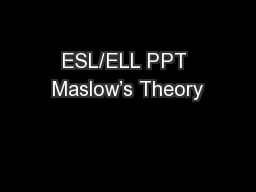

Barriers to Learning Jigsaw MiniLesson Todays Agenda Homework Work on Barriers to Learning Mini Lessons Daily Objective Students will be able to state how ostracism and labeling have negative impacts on learners ID: 655369
Download Presentation The PPT/PDF document "ESL/ELL PPT Maslow’s Theory" is the property of its rightful owner. Permission is granted to download and print the materials on this web site for personal, non-commercial use only, and to display it on your personal computer provided you do not modify the materials and that you retain all copyright notices contained in the materials. By downloading content from our website, you accept the terms of this agreement.
Slide1
ESL/ELL PPTMaslow’s TheoryBarriers to Learning Jigsaw/ Mini-Lesson
Today’s Agenda
Homework: Work on Barriers to Learning Mini Lessons
Daily Objective
:
Students will be able to state how ostracism and labeling have negative impacts on learners.
Identify causes, preventions, and treatments of major barriers to learningSlide2
Parlez-vous Français?
généreux
bleu
petit
sérieuse
actifSlide3
Μιλήστε ελληνικά
κορί
αγάπη
όνομα
ελπίδα
είναιSlide4
Alphabet Soup…EFL English as a foreign languageESOL English for speakers of other languages
ESL English as a second languageLEP Limited English proficiencyELL English language learners
What’s the difference?!Slide5
Why worry?By 2030 40% of students in U.S. schools will come from non-English speaking backgrounds ---U.S. Census Bureau
ELL students are mainstreamed into subject classesIn Virginia, the ELL population has tripled in the last 10 years
---VATESOL newsletter December 2006Title III of No Child Left Behind “to help ensure that children who are limited English proficient, including immigrant children and youth, attain English proficiency, develop high levels of academic attainment in English, and meet the same challenging State academic content and student academic achievement standards as all children are expected to meet;”
---California Department of EducationSlide6
Acquiring Language BICS (Basic Interpersonal Communication Skills)
take 6 months to 2 or more yearsCALP (Cognitive Academic Language Proficiency)
takes 7 to 9 years to achieveListening comes first!
silent period-6 months to 2 years
Factors that affect fluency… -prior academic experience
-family literacy level and expectations -special ed or other services -study of English in native country
-emotional factors Slide7
Who is eligible for ELL?Primary or home language is not EnglishScores below “fluent” on a placement assessmentSlide8
Tips for TeachersSpeak at a slower rateEnunciate clearly
Avoid using idioms and slangAdd gestures and visuals
Write clearly in printDevelop and maintain routines-have an agenda or list of activitiesRepeat and review info frequentlyParaphrase and rephrase
Check assignments for cultural bias
Use multicultural materials as much as possibleDo not discourage use of native language Collaborate with ELL teacher-English through contentSlide9
How should assignments be modified?Assign less homeworkModify tests and quizzes
Allow students to use bilingual dictionariesUse portfolio assessmentAllow more time for completion of work
Use peer tutoring or cooperative learningSlide10
Food for thought!The English language There is no egg in eggplant, nor ham in hamburger; neither apple or pine in pineapple. And while no one knows what is in a hotdog, you can be pretty sure it isn't canine. English muffins were not invented in England nor French fries in France.
Sweetmeats are candies, while sweetbreads, which aren't sweet, are meat. We take English for granted. But if we explore its paradoxes, we find that quicksand can work slowly, boxing rings are square, and guinea pig is neither from Guinea nor is it a pig. And why is it that writers write, but fingers don't fing, grocers don't groce, and hammers don't ham? If the plural of tooth is teeth, why isn't the plural of booth, beeth? One goose, 2 geese. So one moose, two meese? Is cheese the plural of choose? One mouse, 2 mice. One louse, 2 lice. One house, 2 hice?
If teachers taught, why don't preachers praught? If a vegetarian eats vegetables, what does a humanitarian eat? Why do people recite at a play, and play at a recital? Ship by truck or car and send cargo by ship? Have noses that run and feet that smell? Park on driveways and drive on parkways? How can a slim chance and a fat chance be the same, while a wise man and a wise guy are opposites? How can the weather be hot as hell one day and cold as hell another? When a house burns up, it burns down. You fill in a form by filling it out and an alarm clock goes off by going on. You get in and out of a car, yet you get on and off a bus. When the stars are out, they are visible, but when the lights are out, they are invisible. And why, when I wind up my watch, I start it, but when I wind up this essay, I end it? (Author unknown)Slide11Slide12
What else?
What “other” things going on can have an effect on student learning. Think life.Slide13
BARRIERS TO LEARNINGWhat ELSE gets in the way of students’ success?Slide14
BARRIERS to LEARNING: MINI LESSONSAbuse and NeglectBullying;
Substance AbuseDepression & Suicidal TendenciesEating DisordersLatchkey Kids
Teen Pregnancy PovertySleep Deprivation Death, Dying & GriefSlide15Slide16
BARRIERS to LEARNING: MINI LESSONS Students will teach “mini-lessons” on additional Barriers to Learning
Randomly selected barriers Minimum of 4 PowerPoint slides; Maximum of 8
Student Handout Use material from mandatory source and minimum of 1 additional and credible source 5-7 minutes Presentation skills: voice, eye contact, etc.